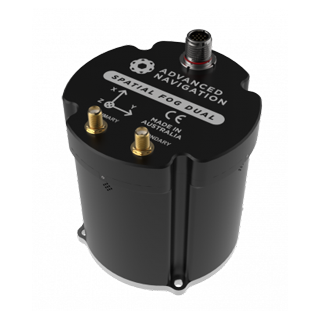-
 FOG
FOGSpatial FOG Dual
Spatial FOG Dual is a ruggedized GPS aided inertial navigation system and AHRS that provides accurate position, velocity, acceleration and orientation under the most demanding conditions.Spatial FOG Dual
Spatial FOG Dual is a rugged GNSS/INS that provides accurate position, velocity, acceleration, and orientation under the most demanding conditions.
Roll & Pitch 0.01 °
Heading (GNSS) 0.01 °
Bias Instability 0.1 °/hr
Position Accuracy 10 mm
Features

High-Accuracy FOG
Spatial FOG contains the EMCORE TAC-450 fiber optic gyro IMU, which provides very accurate inertial data, beyond the best MEMS technology available. This allows Spatial FOG to achieve very high accuracies and dead reckon without GNSS for extended periods of time. Despite the high accuracy FOG IMU, Spatial FOG has a very competitive price tag that is lower than many MEMS systems on the market.AI Navigation Algorithm
Spatial FOG features Advanced Navigation's revolutionary AI neural network sensor fusion algorithm. This provides accuracy of up to 10 times that of a traditional kalman filter. It was designed for control applications and has a high level of health monitoring and instability prevention to ensure stable and reliable data.
Reliability
Spatial FOG has been designed from the ground up for mission critical control applications where reliability is very important. It is built on top of a safety oriented real time operating system and all software is designed and tested to safety standards with fault tolerance in mind. The hardware is designed and manufactured to mil standards.
Dual Antenna RTK GNSS
Spatial FOG Dual contains a dual frequency RTK GNSS receiver that provides up to 10 mm accuracy positioning and supports all of the current and future satellite navigation systems, including GPS, GLONASS, Galileo, and BeiDou. Dual antenna heading provides high accuracy heading that is not impacted by magnetic interference and has no motion requirements.
Peripherals
Spatial FOG Dual features two general purpose input output pins and two auxiliary RS232/RS422 ports that support an extensive number of peripherals. Including odometer based input for ground vehicles, DVLs and USBLs for underwater navigation, NMEA input/output and more.
-
회사소개
하위메뉴
- 제품
-
사업분야
하위메뉴
-
견적문의
하위메뉴
-
고객지원
하위메뉴
- 해외파트너사
Open menu
